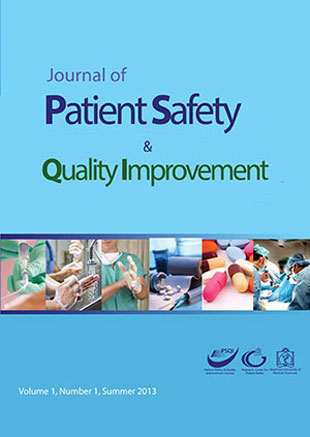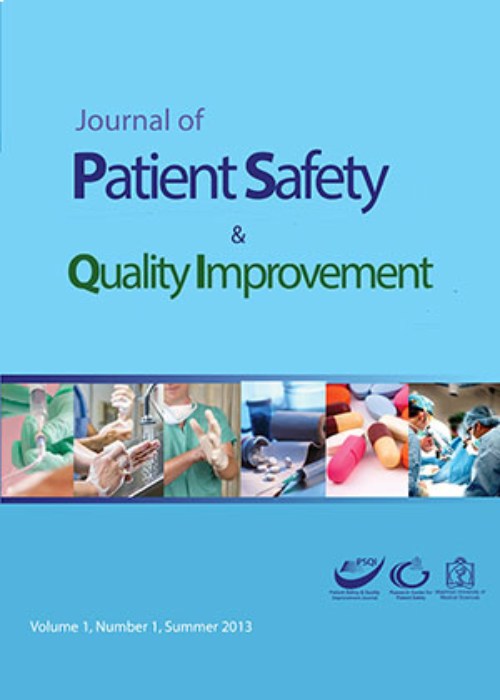فهرست مطالب

Journal Of Patient safety and quality improvement
Volume:1 Issue: 1, Automn 2013
- تاریخ انتشار: 1392/09/12
- تعداد عناوین: 7
-
Pages 1-4ObjectivesPeri-operative aspiration of gastric contents is a problem that causes certain respiratory problems including ARDS. Prophylaxis against aspiration of gastric contents is performed routinely in elective surgeries, but there is rare evidence on the efficacy of this method in emergency cesarean section.Materials And MethodsThis is a randomized, controlled, double-blinded clinical trial. 60 parturients undergoing emergency cesarean section were randomly assigned into three groups of 20 each. They were allocated into two study and one placebo groups. The study group one and two received intravenous ranitidine (IV) 50 mg or IV pantoprazole 40 mg, half an hour before induction of GA, respectively. The placebo group was administered just 5 ml of isotonic saline half an hour before GA induction. After intubation and confirmation of endotracheal tube insertion, the gastric contents were aspirated through a nasogastric tube for evaluation of acidity and volume.ResultsA statistical difference between group one and two with the control group was observed in the acidity of gastric contents, but there was no difference in volume. Also, the PH level of gastric contents in patients receiving pantoprazole was significantly higher than the isotonic saline (p<0.001) and ranitidine groups. The difference in average level of acidity of gastric contents in patients receiving pantoprazole and ranitidine showed a marginal significance (p≤0.036).ConclusionOur findings revealed that pre-operative administration of H2-blockers and proton pump inhibitors (PPIs) effectively decrease the acidity of gastric contents even in emergency cesarean sections. In addition, if the data had an isotonic distribution, or if there were a large number of cases in different clinical groups, PPIs could possibly be more effective.Keywords: Caesarian section, Pantoprazole, Pulmonary aspiration, Ranitidine
-
Pages 5-9ObjectivesIn this study, our aim was to evaluate and classify the voluntary error reports in the hospitals of Mashhad University of Medical Sciences. Patients have the right to receive health care in accordance to the best standards. Health care carries a risk of harm for patient safety, and with respect to today’s stressful systems with a large number of patients, it would be inevitable. The meaning of risk management is to predict adverse events and reduce their occurrence.Materials And MethodsA voluntary medical error reporting form was designed and approved by the clinical governance team of Mashhad Medical University. They were then distributed inside hospitals in the way in which everyone (health providers and patients) could access them easily. The forms were collected and classified monthly in all wards. Classification was performed on the base of type, outcome and reporter. Data gathering took place from spring to autumn 2012. The data was analyzed by the SPSS software.Results2500 errors were extracted from 1000 voluntary error reporting forms of the 12 hospitals of Mashhad Medical University. The most frequent error type was treatment errors (36%) related to drug administration, standard procedures and surgical events.ConclusionsError reporting as a basic activity has an important role in discovering pitfalls of the health care system. To promote the reporting culture, its non punitive base must become clear for all professors and staff members, because this kind of reporting could lead to fewer medical errors and higher staff awareness about probable errors.Keywords: Voluntary error reporting, Hospital, Patient
-
Pages 10-12ObjectivesTo detect the prevalence of Meckel''s Diverticulum in children and adults aged 1 day to 90 years old.Materials And MethodsThis is a cross sectional descriptive study of 1000 cases aged 1 day to 90 years old in the surgery wards of two educational hospitals, Mashhad, Iran from 1998 to 2004. The prevalence of Meckel''s diverticulum, age, sex, and chief complain of patient and the site and size of the diverticulum were evaluated.ResultsMeckel''s diverticulum was seen in 5.4% of patients. 62% of patients were younger than 2 years and 80% were male. Gastrointestinal and obstructive symptoms were the most common presenting feature of the condition (38%). Meckel’s diverticulum was observed at 40-59 cm distance from the ileosecal valve with 1-1.49cm length and 0.5-0.99 cm width.ConclusionMeckel’s diverticulum was more common in children younger than 2 years and was presented by GI obstructive signs in most patients.Keywords: Children, Laparatomy, Meckel Diverticulum, Prevalence
-
Pages 13-18ObjectivesA new and unique tool for survival of organizations among their competitors is the use of organizational intelligence; Organizational intelligence means having a comprehensive knowledge of all the environmental factors that affect on the organization. This research is one of the few studies with the aim of determine the organizational intelligence level of hospitals and ranking of organizational intelligence components to enable administrators to provide more accurate identification of strengths and weaknesses and take more effective steps to improve service delivery.Materials And MethodsThis is a descriptive-analytical and applicable study performed in the 2012 at 12 General Hospital related to Mashhad University of Medical Sciences. Data collection was performed by Albrecht organizational intelligence questionnaire. The data gathering tool was the questionnaire Albrecht Organizational Intelligence. The collected Data were analyzed using T-test and Smirnov test with SPSS-16 software. The significance level for all tests was considered 0.05.ResultsAll components of organizational intelligence were in the optimum status. Component of Shared fate gained the first rank and component of knowledge Deployment gained the last rank.ConclusionRanking of organizational intelligence components is different in hospitals of the province and the county; representing different features and conditions. Considering the importance of organizational intelligence role in the promotion of organization, hospital managers can take active steps to improve organizational intelligence based on done rankings.Keywords: Component of organizational intelligence, Hospital, Organizational intelligence
-
Pages 19-22ObjectivesPoisoned patients are at risk of impaired ventilation in many situations. The purpose of this descriptive study was to investigate the impact of educational workshops on nurses'' knowledge, confidence, and attitude in taking care of poisoned patients.Materials And MethodsThis descriptive study was performed on 60 nursing staff in the intensive care unit (ICU) for poisoned patients in Imam Reza (p) hospital, Mashhad, Iran. Data was gathered by a researcher-designed questionnaire. Studied scales included perceived importance and novelty of educational meeting, matching with professional and educational needs, illustration of practical and knowledge weaknesses and strength and finally satisfaction in holding regular workshops annually. Two, half day workshops were held and various items were taught with various methods. The knowledge of participants was assessed by pretests and post-tests consisting of 12 items related to workshop topics. The impact of these educational meetings was evaluated and the results were analyzed by the SPSS software.ResultsAccording to the results, workshops improved awareness of nurses about their weakness and strength points, professional knowledge and their interest and attention; likewise all participants had the same opinion about a strong need to hold similar workshops more than once and preferably 2 to 3 times annually.ConclusionIt seems that short educational courses in small groups for reviewing the old data and recent findings in the context of critical care are useful in order to promote the knowledge and skills of ICU staff in taking care of poisoned patientsKeywords: Education, Intensive care unit, Nurses, Poisoning
-
Pages 23-29ObjectivesThis study was designed to determine the level of awareness and attitude toward refractive correction methods in a randomly selected population in Mashhad, Iran.Materials And MethodsA random cluster sampling method was applied to choose 193 subjects aged 12 years and above from Mashhad population. A structured questionnaire with open-ended and closed-ended questions was designed to gather the participants'' demographic data such as: gender, age, educational status and occupation, as well as their awareness and attitude toward refractive correction methods (Spectacles, Contact lenses and Refractive surgery).ResultsIn overall, 39% of the participants had a clear perception of ''ophthalmologist'' and ''optometrist'' terms. 80.3%, 87% and 71% of respondents had no information of contact lens application instead of spectacles, cosmetic contact lenses and contact lenses with both refractive correction and cosmetic properties, respectively. 82.5% of participants were not aware of the possibility of refractive surgery for improving their eyesight and decreasing their dependency on spectacles. Awareness about contact lenses and refractive surgery’s adverse effects were only 16% and 8%, respectively.ConclusionAwareness and perception of refractive correction methods was low among the participants of this study. Although, ophthalmologists were the first source of consultation on sight impairments among respondents, a predominant percentage of subjects were not even aware of obvious differences between an ophthalmologist and an optometrist. These findings emphasize the necessity for proper public education on ophthalmic care and the available services, specially the new correction methods for improvement of quality of life.Keywords: Attitude, Awareness, Refractive correction, Refractive error
-
Pages 30-33IntroductionDiagnostic errors have a natural complexity. Medical diagnoses make up a large proportion of all medical errors and cause much suffering and harm. Compared to other types of error, diagnostic errors receive little attention-a major factor in continuity of unacceptable rates of diagnostic error. Case: A 55-year-old woman presented to the emergency department (ED) complaining of bone pain which has been started a month ago and increased gradually in the upper right thigh. Following the emergency evaluation she was sent home with pain medication. On the second visit, a femur neck fracture was seen in the x-ray. She underwent hemiarthroplasty and was discharged. Over several weeks she was reevaluated by many Physicians, because of her worsening pain. In the third visit after the surgery, her x-ray showed bone destruction and following bone biopsy, malignant paraganglioma was diagnosed. Discussion and solution: In all cases in which patient comes to us with skeletal pain, getting a comprehensive history and a full physical examination are prior to lab tests and x-rays. Bone metastasis which can develop severe pain and pathological fractures, is common in patients with malignant paraganglioma. Effective steps for diagnostic error prevention are: Considering the diagnostic error in the normal range of quality assurance surveillance and review, identifying the elements leading to diagnostic errors and getting feedback on the diagnoses Physicians make, in order to improve their skills.ConclusionIt is an every health system priority to identify, analyze, and prevent diagnostic errors in order to improve patient safetyKeywords: Bone Metastase, Diagnostic Error, Malignant Paraganglioma, Medical Error, Pathologic Fracture


